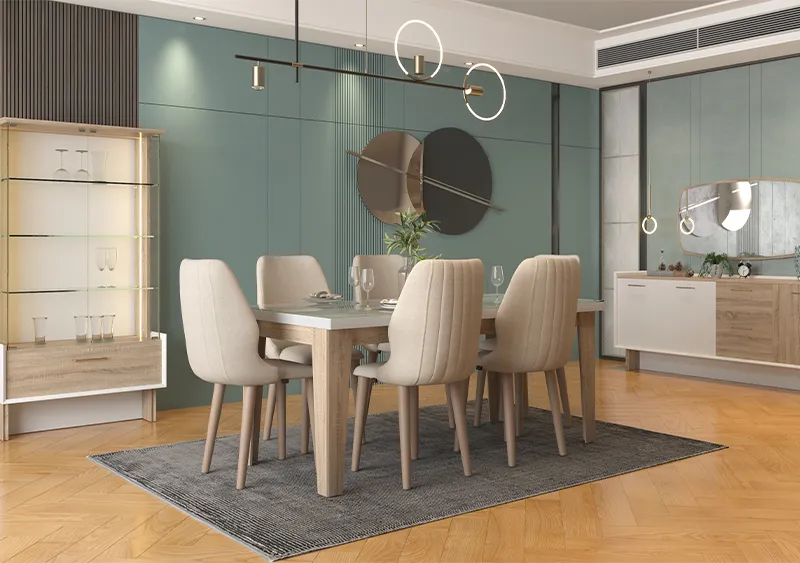Who Can Benefit from a 3D Furniture Modelling Company?
Who Gains the Most from 3D Furniture Modeling Services?

7 MIN READ
April 2, 2025

Written By
Rahimudeen M
Furniture is no longer sold with static photos and basic descriptions. Customers now expect interactive, detailed visuals that show how a product looks, feels, and fits in their space. This shift has made 3D furniture modeling a powerful tool for a wide range of industries.
It’s not just furniture manufacturers using it. E-commerce retailers, interior designers, architects, and even branding agencies are leveraging 3D models to improve customer experience, speed up production, and drive better business outcomes.
In this blog, we’ll explore exactly who benefits from partnering with a 3D furniture modeling company and how these visuals are transforming workflows across different sectors.
Let's take a closer look.
Who Benefits Most from 3D Furniture Modeling? Use Cases Across the Industry?
3D furniture modeling is no longer a niche service. It has become a must-have across multiple industries where visual accuracy, speed, and digital flexibility play a critical role. Whether you're designing, selling, or marketing furniture, this technology offers tools that reduce costs, save time, and improve customer experience.
Let’s break down how different industries are benefiting from partnering with 3D furniture modeling companies.
1. Furniture Manufacturers: Design Smarter, Waste Less
Manufacturers often face long product development cycles, expensive prototyping, and avoidable production errors. 3D modeling simplifies all of that.
Design teams can explore styles, materials, and dimensions in a virtual environment. Physical prototypes are only created when a design is truly ready. This reduces waste, shortens timelines, and eliminates guesswork. The result is a more streamlined and cost-effective development process.
Learn more about how 3D modeling helps furniture businesses grow
2. Interior Designers and Architects: Communicate Concepts Clearly
Designers and architects often struggle to translate creative vision into visuals that clients understand. 3D models solve this by showing how specific furniture pieces will look and fit within a planned space.
Clients can walk through a fully furnished room, evaluate proportions, and make confident choices without needing technical expertise. It improves collaboration, speeds up approval, and builds trust in the design process.
3. Furniture Retailers: Better Displays, Fewer Returns
Retailers know the power of visuals. In a showroom, products speak for themselves. Online, you need to make that same impact digitally.
3D renderings offer multiple views, zoomed-in textures, and lifestyle setups that go far beyond traditional photography. This helps customers get a clear understanding of the product, leading to fewer returns and stronger online conversions.
4. E-Commerce Brands and Marketplaces: Offer Immersive Shopping
Digital-first brands rely on technology to compete. With 3D furniture models, they can create a personalized and interactive shopping experience.
Customers can place furniture in their rooms using AR, explore customizable finishes, or rotate items to view them from every angle. These features increase engagement and give customers more control over their purchase decisions. To learn more about how AR and VR are transforming e-commerce, check out our in-depth article.
5. Marketing and Creative Agencies: Produce Campaigns Faster
Creative teams are often under pressure to launch campaigns before products are physically available. 3D modeling solves that challenge.
By generating photo-realistic images from digital models, agencies can create brochures, ads, and website content on demand. It also allows teams to update assets quickly without reshooting or rebuilding sets.
6. Product Developers and R&D Teams: Test Ideas Before Production
In product development, precision is key. 3D modeling provides visual clarity and functionality before committing to physical prototypes.
Designers can run simulations to test assembly, adjust ergonomics, and visualize the final product with more accuracy. This reduces costly revisions and speeds up the entire development cycle. Discover how high-precision 3D modeling services can optimize your process .
7. Real Estate and Property Developers: Stage Properties Virtually
Empty spaces can be hard to sell. Buyers need to visualize how a home or office might look fully furnished.
Using 3D furniture models, developers can virtually furnish properties with style variations that appeal to different audiences. It’s faster, cheaper, and more flexible than physical staging, especially for presales or remote viewings.
How ZealousXR Supports These Industries
3D modeling is no longer a one-size-fits-all solution. Each industry has different visual needs, technical expectations, and creative goals. That’s why ZealousXR doesn’t just deliver models—we build tailored 3D visualization workflows that fit the exact demands of your business.
From rapid prototyping to high-volume e-commerce content, here's how ZealousXR adds value across the board:
For Furniture Manufacturers
ZealousXR helps manufacturers shorten the product development cycle by creating accurate, editable 3D models that replicate materials, finishes, and construction details.
- Design teams can test new product concepts digitally before sampling
- Sales teams get render-ready visuals for catalogs and pre-launch campaigns
- Custom modeling pipelines allow brands to roll out large collections quickly
We collaborate directly with design and engineering departments to ensure everything we model is not just beautiful, but manufacturable.
For Interior Designers and Architects
Working with ZealousXR gives designers access to a rich library of customizable 3D furniture models that fit perfectly into their architectural plans and visual presentations.
- We provide assets compatible with tools like SketchUp, Revit, and 3ds Max
- Our models are optimized for both still rendering and real-time walkthroughs
- Designers can request custom finishes, dimensions, or styles
This helps firms present their creative vision clearly—whether they’re pitching a concept or walking a client through a fully rendered space.
For Furniture Retailers and E-Commerce Brands
Retailers rely on speed and visual quality. ZealousXR offers scalable rendering services designed specifically for digital storefronts, product pages, and AR integrations.
- Photorealistic renders for every color and configuration
- 360-degree product views and interactive experiences
- AR-compatible models that enhance mobile shopping
We work with retail teams to maintain brand consistency while adapting visuals for different platforms, screen sizes, and campaigns.
For Marketing & Creative Agencies
ZealousXR acts as an extension of your creative team, delivering high-quality visuals—even when the product doesn’t exist yet.
- Need lifestyle scenes for a campaign launch? We build environments from scratch
- Tight deadline? Our pipeline supports fast turnarounds without compromising quality
- Managing a multi-brand rollout? We create asset libraries that scale
You get control, creative flexibility, and studio-quality rendering—without the need for a physical shoot.
For Product Developers and R&D Teams
Before a product hits production, teams need to visualize design options, review structure, and collaborate across departments. We support this by delivering editable, detail-rich 3D models that reflect the intended function and appearance of the product.
- Our models can be used for internal presentations, investor decks, or early-stage testing
- Developers can request rapid iterations to explore different concepts
- Teams can use renders for early feedback before committing to prototypes
This not only reduces development time but also helps brands avoid costly revisions during production.
For Real Estate Developers and Property Marketing Teams
ZealousXR brings empty properties to life through digital staging, immersive tours, and virtual showrooms.
- We furnish model homes and rental units with 3D furniture tailored to the target buyer
- Our visuals support digital walkthroughs, AR tools, and international sales
- We help speed up property sales while reducing physical staging costs
Whether it’s for brochures, websites, or remote buyers, we give properties a personality buyers can connect with.
Final thoughts
Your Product Has Potential. Let the Right Visuals Show It.
No matter how well-crafted your furniture is, customers can't fall in love with what they can't see clearly. That’s why 3D modeling is no longer a nice-to-have—it’s the foundation of how modern furniture brands, designers, and retailers communicate value, precision, and style.
But great visuals don’t just happen. They’re built with intention, accuracy, and a deep understanding of industry needs.
That’s where ZealousXR comes in.
We don’t just create stunning renders—we help businesses turn ideas into assets, and assets into results. Whether you're trying to impress a client, boost e-commerce conversions, or reduce prototyping waste, we offer tailored 3D modeling solutions that meet you where you are and scale as you grow.
About the writer :
Rahimudeen M is the Senior Operations Manager at Zealous Services, with over 17 years of experience in project ... management and client success. He ensures smooth operations across 3D visualization, animation, and modeling projects. A natural leader, Rahimudeen is passionate about building high-performing teams and delivering top-tier results for clients across global markets.
Read MoreFrequently Asked Questions (FAQ)
1. Do I need 3D furniture modeling if I already have product photography?
Yes, 3D modeling offers far more flexibility than traditional photography. Once a model is created, it can be reused across marketing campaigns, product pages, AR experiences, and customization tools—without the need for physical products or repeated photoshoots.
2. How can interior designers and architects use 3D models in their work?
They can integrate furniture models into room layouts or architectural renderings to help clients visualize the full space. This makes it easier to present design ideas, adjust scale or style in real time, and speed up client approvals.
3. Is 3D furniture modeling only useful for online brands?
Not at all. In-store retailers use 3D visuals for catalogs, signage, and digital displays. Developers use them for virtual staging. Marketing teams use them to generate campaign visuals quickly. The applications go far beyond e-commerce.
4. How does 3D modeling help with product development?
R&D teams use 3D models to explore design concepts, run simulations, and communicate ideas across departments. It helps identify flaws, test proportions, and refine features before manufacturing begins—saving time and resources.
5. Can small businesses benefit from 3D furniture modeling services?
Absolutely. With scalable packages and pay-per-project options, small and growing brands can access high-quality visuals without the cost of building an in-house team. It’s a practical way to compete visually with larger players in the market